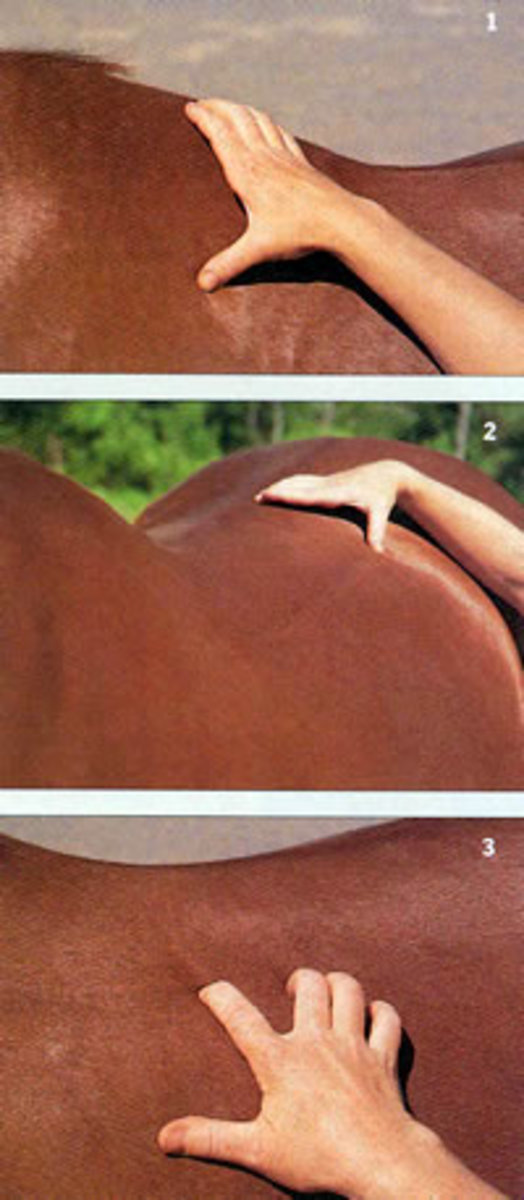Does your horse object to being saddled? If he does, don’t assume he’s trying to get out of work. He’s much more likely, in my opinion, to be tryng to tell you that the saddle itself, where it sits, or how it fits hurts his back.

Of the horses brought to my practice with what their owners describe as performance problems, I find that an average of 23 out of 25 have at least moderate back pain related in some way to their saddles. That’s the bad news. The good news is that once the pain is relieved, in nearly every case the performance problems disappear–sometimes overnight.
CHECK FOR BACK PAIN
1. Rest your fingers on your horse’s spine and reach your thumb down to the hollow just behind the withers, about four or five inches down on most horses. That’s the starting point of the acupuncture pathway…
2. …along which you’ll test for back pain. Mark the point with your thumb (if he’s a little dusty, so much the better)…
3. …and then press into the muscle every inch and a half or two inches along the pathway. If he feels tense and tight, he’s sore; if he “splints” (stiffens) his back, he’s really sore.
CHECK YOUR SADDLE’S CONSTRUCTION
First check your upside-down saddle for symmetry: The panels should be the same shape and fully stuffed.
1. Turn your saddle right-side-up and look at it from the front to see that the tree is symmetrical.

2. Then, looking down on the saddle as you brace it against your thigh, make sure that the buttons are perfectly parallel (if not, the tree is twisted) and that the flaps are straight (if not, the tree may be twisted).
CHECK YOUR SADDLE’S POSITION
Most horses–in every sport, with the possible exception of dressage horses–wear their saddles too far forward.
To place your horse’s saddle properly, put it up by his withers but then slide it back to where his conformation stops it naturally. That will get the tree off his shoulder blades and leave him free to step out. (Having the flaps over the shoulder blades, as many jumping saddles do, is OK; they’re soft, so they won’t dig in or restrict his movement.)
To check that the saddle’s in the right place, look for a flat area on his underside three to five inches behind the elbow, just in front of where his belly starts to widen. If your girth crosses this spot, the saddle is where it should be.
CHECK YOUR SADDLE’S FIT
1. With your saddle correctly positioned, put your hand underneath and slide your fingers along the panel. If it doesn’t feel equally snug from front to back, it’s “bridging”–and the places where it’s tight will becomes sore from the extra pressure.

2. To check the fit of the saddle tree, position one crop or dressage whip against your horse’s wither and one along the line of the tree (which usually follows the seam of the saddle). If the tree fits your horse, the whips won’t cross.
3. If they cross above the withers, like this, the tree is too wide (a problem you can usually correct with padding).
4. If they cross below, like this, it’s too narrow–a problem padding can’t fix. A new saddle is the only solution.
–Photos by Mandy Lorraine
Dr. Joyce Harman is a veterinarian and respected saddle-fitting expert certified in veterinary acupuncture and veterinary chiropractic; she is also trained in homeopathy and herbal medicine. Her Harmany Equine Clinic is in northern Virginia, and she is the author of The Horse’s Pain-Free Back and Saddle-Fit Book available at www.EquineNetworkStore.com.
Excerpted from “Seat of the Problem?” in the January 1994 issue of Practical Horseman magazine.










